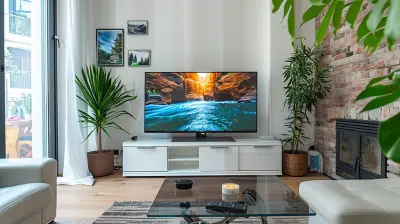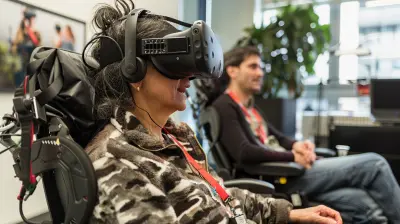Smart TV Display Technologies: Breaking Down the Differences
1 September 2025
When you’re shopping for a new Smart TV, it’s easy to get overwhelmed by all the tech jargon flying around. OLED, QLED, Mini-LED, MicroLED — what does it all mean? They all sound futuristic, but these aren’t just marketing buzzwords. These are the core display technologies that define how your TV looks, feels, and performs in real-world viewing.
Let’s break it all down, nice and easy. Whether you’re a movie buff, a gamer, or just someone wanting the best picture while binge-watching, this guide will walk you through the major Smart TV display technologies, so you know exactly what you’re paying for.
What Are Smart TV Display Technologies?
At its core, display technology is the way your TV produces images. That includes how light is created, how colors are rendered, how bright the screen gets, and how deep the blacks look. Smart TVs use a few different technologies to achieve this, and each has its pros and cons.So, before you swipe your card or click “Add to Cart,” you’ll want to know the difference between LED, OLED, QLED, Mini-LED, and the emerging MicroLED.
1. LED – The Old Reliable
What is LED?
LED stands for Light Emitting Diode. While many people refer to these as “LED TVs,” they’re technically LCD TVs with LED backlighting. These TVs have been around for a while and have improved a lot over the years.How It Works
An LED TV uses a backlight positioned behind an LCD panel. This panel controls how the light gets through to create images.Pros
- Affordable for most budgets- Bright screens, great for sunny rooms
- Widely available in many sizes
Cons
- Blacks can look grayish in dark scenes- Viewing angles can be limited
- Not the best for cinematic experiences
Who’s It For?
If you want a decent picture without breaking the bank and aren’t fussed about ultra-deep blacks or crazy contrast, LED TVs are a solid choice.
2. OLED – The King of Contrast
What is OLED?
OLED stands for Organic Light Emitting Diode. Unlike LED TVs, OLED panels have no backlight. Each pixel creates its own light and can turn on or off independently.How It Works
Think of every pixel as a tiny light bulb. If it needs to display black, it simply turns off — no light at all. That’s how OLED achieves that pitch-black, inky darkness.Pros
- Perfect blacks and infinite contrast- Stunning color accuracy
- Super thin and lightweight panels
- Wide viewing angles
Cons
- Can be expensive- Risk of image retention or burn-in (though rare with newer models)
- Not as bright as other types, especially in very bright rooms
Who’s It For?
If you're all about image quality — watching movies in dim lighting, enjoying HDR content, or gaming with razor-sharp visuals — OLED is the luxury ride you want.
3. QLED – Samsung's Bright Idea
What is QLED?
QLED, short for Quantum Dot LED, is Samsung’s take on improving LED technology. It still uses a backlight, but adds a layer of quantum dots that enhance color and brightness.How It Works
Those quantum dots are like tiny crystals. When light hits them, they glow in extremely precise colors. This means you get more vibrant and accurate images.Pros
- Super bright — ideal for well-lit rooms- Vibrant colors and great HDR performance
- No risk of burn-in
Cons
- Still relies on a backlight, so blacks aren't totally black- Can be pricey depending on the model
- Not quite OLED-level contrast
Who’s It For?
If you want a bright, colorful screen for family viewing in a bright living room, QLED is a fantastic middle-ground between LED and OLED.4. Mini-LED – The Tiny Giant
What is Mini-LED?
Mini-LED is an evolution of traditional LED technology. As the name suggests, the LED backlights are much smaller — think hundreds to thousands compared to a few dozen in regular LEDs.How It Works
With more LEDs comes more precise control of light and dark areas. It’s kind of like getting the perks of OLED (better contrast, deeper blacks) without giving up the brightness and affordability of traditional LEDs.Pros
- Better contrast than standard LED- High brightness levels
- More affordable than OLED with comparable performance
- Reduced halo effects around bright objects
Cons
- Still can’t match the pixel-level control of OLED- Premium models can get pricey
- Not yet as widespread
Who’s It For?
If you want the best of both worlds — improved contrast, strong brightness, and no burn-in concerns — Mini-LED is quickly becoming the sweet spot.5. MicroLED – The Future is Bright (And Expensive)
What is MicroLED?
MicroLED is the newest kid on the block and looks set to blow everything else out of the water. It combines the best parts of OLED (self-emissive pixels) with the durability and brightness of LED.How It Works
Each pixel in a MicroLED screen is an individual micro-sized LED. That means true blacks, insane contrast, and light control that’s off the charts.Pros
- Incredible picture quality- Bright with perfect blacks
- No burn-in risk
- Long lifespan
Cons
- Extremely expensive- Limited availability
- Mostly found in ultra-large formats
Who’s It For?
Right now? Tech enthusiasts with deep wallets. But give it a few years, and this could be the new standard for high-end TVs.HDR Capabilities: The Hidden Hero of Displays
It’s not just about display tech — HDR (High Dynamic Range) matters a lot too. You’ve probably seen terms like HDR10, Dolby Vision, and HLG being thrown around.A good display is only as good as its HDR support. OLEDs and high-end QLEDs often support multiple HDR formats, making movies pop with detail and color.
Resolution Wars: 4K vs. 8K
Most Smart TVs today are 4K, but 8K is slowly creeping in. But here’s a truth bomb — unless you’re getting a massive screen (we’re talking 70 inches+), you probably won’t notice much difference between the two.So focus more on display tech than sheer resolution; a great OLED 4K TV will look better than a mid-range 8K LED any day.
Choosing the Right Smart TV for You
Let’s keep it simple. Here’s a cheat sheet to help you pick based on what type of viewer you are:| Viewer Type | Best Tech Match | Why? |
|---------------------|-----------------------|-------------------------------------------|
| Budget Shopper | LED | Affordable, does the job |
| Movie Lover | OLED / Mini-LED | Deep blacks, cinematic quality |
| Bright Room Viewer | QLED / Mini-LED | Bright and vibrant, no glare issues |
| Gamer | OLED or Mini-LED (120Hz+) | Fast refresh, great visuals, low latency |
| Future-Proof Seeker | MicroLED (when affordable) | Cutting-edge, long lifespan |
The Final Verdict
Picking a TV isn’t just about size or smart features anymore. The display technology under the hood defines your entire viewing experience. Want deep, dark Netflix nights? Go OLED. Need bright, punchy cartoons for the kids? QLED’s your friend. Looking to balance performance and price? Mini-LED might be your golden ticket.Think of your TV like a window into your favorite worlds — movies, games, sports, and shows. The cleaner and more colorful that window is, the better your experience will be. So don’t just go big, go smart about your screen tech.
Frequently Asked Questions
1. Is OLED better than QLED?
Depends on what you value. OLED offers deeper blacks and better contrast, while QLED is usually brighter and better suited for daylight viewing. OLED is often seen as having superior picture quality overall.2. Is burn-in on OLED still a real issue?
Not as much as you think. Modern OLEDs have smart tech to reduce burn-in risks. Unless you’re watching static graphics on loop 24/7, you’re probably fine.3. Should I wait for MicroLED?
Only if you’ve got time and $$$ to spare. MicroLED is amazing, but it’s not mainstream yet. For now, OLED and Mini-LED offer excellent quality for far less.4. What’s the difference between Mini-LED and QLED?
Mini-LED refers to the backlight technology. QLED refers to the color-enhancing layer. Fun fact: Some high-end TVs use both (Mini-LED + QLED) for the best of both worlds.all images in this post were generated using AI tools
Category:
Smart TvsAuthor:

Jerry Graham
Discussion
rate this article
1 comments
Jillian Foster
Understanding display technologies empowers consumers to make informed choices for their viewing experience.
September 21, 2025 at 1:05 PM

Jerry Graham
Absolutely! Knowledge of display technologies enhances consumers' ability to choose the best viewing experience tailored to their needs.


